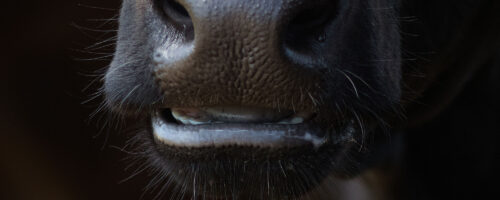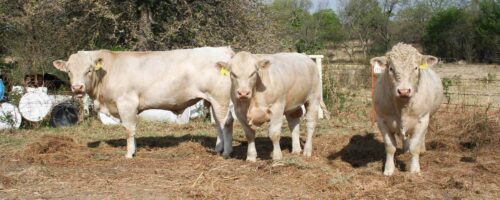Cattle commonly swallow foreign objects, such as nails and wire, found in the field or their feed. These objects do not always cause problems, but they can cause a disease commonly known as hardware disease. Foreign objects ingested by cattle make their way into the animal’s rumen and reticulum. Sometimes, the animal’s body will push the objects into the peritoneal cavity, causing severe inflammation (hardware disease). In extreme cases, a sharp, metal object can damage the animal’s abdomen wall and pierce the heart sac, causing pericarditis. Typical signs of hardware disease are poor appetite, lack of movement and indigestion. If the animal’s heart is damaged, fluid can build up and cause abnormal heart sounds.
It is unlikely that an animal will fully recover from hardware disease, and slaughter may be suggested. If the animal is a dairy cow or highly valuable for breeding purposes, there are a couple treatment options. The animal’s front legs may be raised 6 to 8 inches off the ground to stop the object from moving further into the abdomen. This needs to be done continuously for 10 to 20 days. Antibiotics can be given to slow the infection. It is also possible to manually remove the foreign objects by making an incision into the rumen wall.
The best way to deal with hardware disease is prevention.
Most grain elevators and feed dealers run their feed under magnets to catch any hardware. However, some objects may not be picked up. Cow magnets, which are administered like a pill, are also used to collect metal in the reticulum.
Here at the Noble Research Institute, we use a grinder and feed boxes to feed cattle. We decided to do a test to see how much, if any, hardware is found in our feed. We placed three magnets on two feed box chutes and poured two types of feed, a pelleted receiving ration and a commodity mix in pellet form. These feeds were put in the feed box and poured directly into a feed bunk. No prior mixing was done on our part after purchasing. Our initial findings showed magnets picked up some pellets that contained metal flakes. The magnets also picked up metal not from the feed, including metal pieces from inside the rusted feed box, bolts, nails and welding rods.
The cattle magnets on the feed box chutes work but can easily fall off during use. We are working to mount permanent magnets to the chutes, so they will be more stable and a have better chance of catching more unwanted objects. We are also in the process of installing magnets on our mixer wagon. While grinding hay, we did our magnet test and found pieces of rake teeth, fence posts and wire that was picked up by the hay baler. When feeding without the magnets, we weren’t finding many objects in the feed bunks. This tells us the objects we are catching now were going somewhere else more than likely into the cattle’s stomach.



Comment